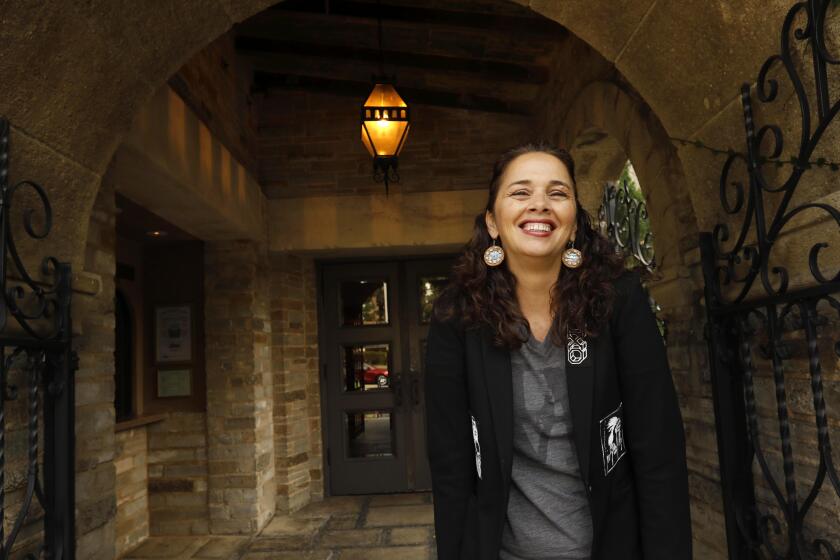Restored ‘Abbot Kinney’ mural anchors exhibit on Venice history
Edward Biberman’s New-Deal mural “Abbot Kinney and the Story of Venice” — a bustling, three-part tableau from 1941 that hung in the Venice Post Office until it closed in 2012 — brims with drama.
Dead center: The founder of Venice, pictured under an Italian-style archway with piercing eyes, bushy mustache and grim expression, dares anyone to defy his idyllic vision for a small, upscale resort town by the sea. Behind him, slender gondolas, circa 1905, float in canals lined with bungalows — all bathed in sunny pastels, a haze of nostalgia.
Kinney is flanked by images from the ‘40s. To his right, a crowded beach scene in which sailors court their dates, sun worshipers savor glistening ice cream cones and crowded amusement park rides dot the horizon; to his left, men in fitted suits huddle before a more ominous landscape of oil rigs and holding tanks.
The recently restored mural is the centerpiece of the Los Angeles County Museum of Art’s small but robust exhibit, which brings to life all the mural’s pictorial elements through additional Biberman artworks, rare historical documents and glass cases full of Venice ephemera.
The Biberman mural was commissioned in the early ‘40s by the Treasury Department’s Section of the Fine Arts and is one of the better New Deal murals, artistically, says Ilene Susan Fort, senior curator of American Art at LACMA.
“Historically, it’s also very relevant,” she says. “It has elements of fun, it’s brightly colored, the details are quite amusing. But at the same time, Biberman, on the right side of the painting, was quite honest about the intrusion of the oil rigs and wells and how the oil industry, at that time, was ruining the beaches.”
When film producer Joel Silver (“The Matrix,” “Sherlock Holmes”) bought the Windward Circle post office building in 2012 with plans to make it the home of his production company, Silver Pictures, he was captivated by Biberman’s work. Silver, who also bought and restored the Frank Lloyd Wright-built Storer House in the Hollywood Hills, fronted about $100,000 for the mural’s top-to-bottom, year-plus restoration. The Postal Service still owns the artwork, but Silver has a long-term lease on it and plans to re-install the artwork in its former location on completion of his office space, planned for late 2015. At that point, he’ll initiate a program for the public to be able to view it.
In the LACMA exhibit, the black-and-white photograph of Kinney that Biberman likely used as a model for his mural hangs nearby, alongside vintage postcards and photographs of Venice. Kinney’s original architectural plans for his seaside town, as well as lively real estate brochures and concert souvenir programs, capture his hopes and entrepreneurial spirit. Collectively, the images chart an evolution from swampy marshlands. For context, a LACMA painting of Venice, Italy, by Giovanni Antonio Canal, a.k.a. Canaletto, hangs opposite Biberman’s mural.
“There are all these invisible threads that go from the mural to the walls and from one wall to another,” says Susan L. Power, LACMA’s research assistant of American art, who co-curated the exhibit. “We wanted to open it up and make it come alive.”
This Saturday, another invisible line will be drawn, this one between the exhibit and Venice’s vibrant literary history. George Drury Smith, the 86-year-old founder of the literary magazine Beyond Baroque and a founding member of Beyond Baroque Literary Arts Center, will give a talk in the museum’s Brown Auditorium about the Venice literary scene in the ‘60s and ‘70s. Poet Bill Mohr, author of “Holdouts: The Los Angeles Poetry Renaissance 1948-1992,” will read his work as well as poems by Beat Generation writers and other longtime Venice scribes before a mural viewing.
“The last talk around this [in the gallery] was so popular, security was worried about the artworks and we had to move the event to an auditorium setting,” Fort says, “but we feel everyone deserves the right to see the artwork, so we’ll bring them up afterward — it really rounds out the story.”
More to Read
The biggest entertainment stories
Get our big stories about Hollywood, film, television, music, arts, culture and more right in your inbox as soon as they publish.
You may occasionally receive promotional content from the Los Angeles Times.







